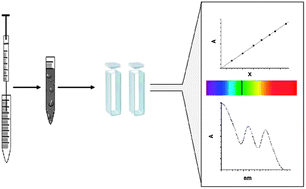Development of a dispersive liquid–liquid microextraction method for iron extraction and preconcentration in water samples with different salinities
Ederson Rodrigues Pereira, Bruno Meira Soares, Juliana Villela Maciel, Sergiane Souza Caldas, Carlos Francisco Ferreira de Andrade, Ednei Gilberto Primel, Fabio Andrei Duarte
Periódico: Analytical Methods
DOI: https://doi.org/10.1039/C3AY26294D
Abstract
A new, efficient, fast and simple method for iron determination in environmental water samples with different salinities by a dispersive liquid–liquid microextraction method, followed by UV-Vis spectrophotometric determination, was developed. In this study, Fe was complexed with ammonium pyrrolidinedithiocarbamate and extracted into 1,2-dichlorobenzene droplets after the injection of a mixture composed of 1,2-dichlorobenzene (extraction solvent) and ethanol (dispersive solvent) into the sample solution. Factors which affected the efficiency of Fe extraction and its subsequent spectrophotometric determination were studied and optimized. Under optimized conditions, the calibration curve was linear and ranged from 0.02 to 2.5 mg L-1 (r = 0.999). The limits of method detection and quantification were 6.1 and 18.3 mg L-1, respectively, with a preconcentration factor of 3.3. The accuracy evaluated in terms of recovery was between 90 and 100% with RSD lower than 12%. In addition, a certified reference material (SRM 1643e, Trace Elements in Water) was analyzed with agreement of 104% and RSD about 5%. The method was applied to total Fe determination in environmental water samples with different salinities and satisfactory results were obtained.
Graphical abstract

